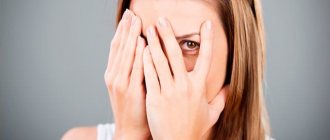Manifestations of anthropophobia, reasons for fear of people
A person with anthropophobia tends to avoid any interaction with society. He may have panic attacks in places with large crowds of people.
Fear of people refers to anxiety conditions that provoke the development of neuroses and depression
Psychiatrists believe that the reasons for this condition lie in the individual’s childhood. Unreasonably strict parents, who seek to correct the child’s behavior through fear and punishment, instill in him fear of people in general.
Frequent criticism and lack of praise hurt feelings and lead to low self-esteem. The individual subconsciously expects negativity from the environment towards him and strives to minimize contacts.
In psychology, the reasons for the appearance of fear of people include:
- Traumatic situations experienced in childhood, adolescence and adulthood. This can be either violence (emotional, physical, sexual), or terrorist acts, or other types of aggression from society.
- Increased suspiciousness and vulnerability combined with low self-esteem.
- Rejection, rudeness, ridicule from significant persons in adolescence or childhood.
- Bullying at school or work.
According to psychologists, the lack of “real” communication and constant “hanging out” on social networks can become a catalyst for anthropophobia in people prone to isolation and lack of self-confidence.
The lack of communication skills further lowers self-esteem; a person deliberately avoids contact with people. Over time, this leads to complete avoidance of people.
Causes of fear
Fear of the dark - what is this phobia called, why does fear arise and how to fight it
The science of psychology does not name the exact reasons for the development of anthropophobia; it is often formed as a result of psychological childhood trauma. Possible reasons:
- education in strictness;
- moral and physical violence;
- living in unfavorable conditions;
- growing up in a dysfunctional family;
- stressful situations;
- appearance features;
- conflict situations in the family, kindergarten, school.
The child is afraid
A phobia often develops in people with low self-esteem who have been subject to frequent criticism from family and friends. Sometimes anthropophobia appears at a conscious age after difficult life situations: conflicts, betrayal, violence.
Note! Sometimes a phobia can appear after changes in appearance. For example, after losing weight, hostility towards overweight people arises.
Symptoms of anthropophobia, how to determine the presence of anthropophobia
Fear of people can manifest itself as an independent condition or as a symptom of other psychiatric diseases and mental disorders.
According to psychologists, the lack of “real” communication and constant “hanging out” on social networks can become a catalyst for anthropophobia
The disease is characterized by:
- Fear of communicating with other people. Panic can be caused by visiting public places or simply going outside.
- Obsessive actions with which a person tries to cope with a phobia. This could be a count of some objects, for example, red cars or the number of steps taken. These could be certain gestures or filler words.
- Strong anxiety when communicating . An anthropophobe does not look his interlocutor or others in the eyes when talking. Speech is intermittent and confused, the speaker confuses himself, stuttering or long pauses between words are possible.
Be sure to read:
Getting rid of obsessive thoughts, depression and fear of death on your own
Fear of people also manifests itself vegetatively. The person suffering from it may have sweaty palms and may tremble. It turns red, spots appear not only on the face, but also on the neck and décolleté. Possible increased heart rate and difficulty breathing, panic attacks.
A person suffering from this phobia constantly worries about how they look. It always seems to him that something is wrong with his hair and clothes.
He is haunted by the feeling that all eyes are directed at him, that even strangers judge him and laugh at him. Some patients fear physical or sexual violence from other people.
Anthropophobia can be determined after a conversation with a psychiatrist or psychotherapist. Sometimes an EEG or MRI is prescribed.
In some cases, additional tests are performed to identify other mental problems that provoke this condition.
What is social phobia
Just a couple of decades ago, no one knew about such a mental disorder in which a person could not communicate with strangers, was very shy and embarrassed when meeting new people, could not speak publicly and often simply avoided society. Doctors believed that detachment from the outside world was not a phobia. This was diagnosed as a neurosis caused by such character traits as timidity, shyness, and a desire for loneliness. But science did not stand still, and after a short time, experts from all over the world came to the general conclusion that such a personality disorder should be classified as a separate group of phobias.
Social phobia, expressed by uncontrolled anxiety and fear of the public, makes social contacts of the patient impossible. With this mental disorder, the body’s reaction under the influence of external factors differs from its reaction in any other stressful situations. The behavior of a social phobe is characterized by specificity, illogicality and irrationality, and the anxious state persists.
A person with symptoms of social phobia finds it difficult to perform any social activities:
- public performance;
- business telephone conversations;
- answers at school or university in front of an audience;
- interviews, etc.
Social fear is to a certain extent caused by the fear of receiving a negative assessment of one’s personality. People are afraid that society will analyze their actions and question every word they say. They are forced to constantly prove something to themselves and others. As a result, social phobes never experience happiness or harmony with themselves and the world around them.
People with this mental disorder tend to be alone and minimize social contacts. They are constantly “on edge”, experiencing severe anxiety and tension, as a result of which the nervous system is exhausted, which leads to depression and somatic disorders. To cope with their problem, completely relax, unwind and relieve anxiety, patients resort to alcohol and psychotropic or narcotic drugs. Such people are not able to manage their lives, self-realization or start a family.
Types of social phobias
Social anxiety can become overly acute when a person experiences panic attacks. With moderate social fear, a person is able to soberly assess the situation and control himself, despite strong anxiety. Social phobes are always in an anxious state, which is classified into two types:
- delineated social phobia - fear manifests itself in similar situations (communicating with salespeople in stores, speaking in front of a large audience, a job interview, taking an exam, etc.);
- generalized - a feeling of fear occurs in many very diverse social situations.
Regardless of the type of social phobia, the signs of the disorder will be the same. But it should be noted that these symptoms can be temporary or permanent. Let's consider an example: during school years, a child was ridiculed by the teacher in front of the whole class when he was answering at the blackboard. After this, he begins to be afraid to tell something in front of an audience, so as not to look stupid anymore.
And another variant of the development of a phobia is also possible, in which the child completely refuses to go to school and even go outside. But usually such childhood fear passes quickly.
But there are times when a person himself does not know why he developed fear of society. He may not even remember how long he has suffered from social anxiety. Usually, for such people, the fear of judgmental glances becomes a life companion and they cannot cope with this problem on their own.
Often a person cannot determine the reasons for his fear of society
Difference between social phobia and sociopathy
Hearing these two terms, one gets the impression that social phobia and sociopathy are almost the same diseases, but in fact the difference between them is significant. If social phobia is a social anxiety disorder, then sociopathy is a dissocial personality disorder. A sociophobe is afraid of society, of performing actions accompanied by attention from strangers. A sociopath is a mentally ill person whose behavior is characterized by aggressiveness and impulsiveness. Typically, such people ignore all social norms, they are conflict-ridden, indifferent to the world around them, unable to form attachments, and often lead an antisocial lifestyle.
Another significant difference between these concepts is that a social phobic person can learn to control and manage their fears. But sociopathy is an acute form of mental illness, and a person cannot recover on his own; for this he needs professional medical help.
Some also equate schizophrenia with social phobia and sociopathy, considering all diseases to be similar. But schizophrenia is a severe mental disorder that affects the functions of consciousness, behavior, thought processes, emotions and even motor function. This is an extremely dangerous and serious illness that has nothing to do with fear of social activities and requires immediate treatment.
How is it different from social phobia?
Both disorders are classified as anxiety-phobic. But a social phobe experiences fear when visiting places with large crowds of people or social events.
Anthropophobia can be determined after a conversation with a psychiatrist or psychotherapist
He is afraid of public speaking, corporate events, family gatherings with a lot of relatives. In this case, a person can communicate without any problems with two or three people.
A sociophobe can work in a small team, have a close friend, and be able to build personal relationships.
An anthropophobe , as a rule, cannot communicate with people at all. He is overcome with anxiety at the thought of meeting a random passerby, the need to contact the salesperson in the store, or the customer service operator.
A person with such a phobia is unable to turn to others for help, even in difficult situations. Anthropophobes have no friends and a complete lack of personal life. They try to rarely leave the house.
Symptoms and manifestations
Anthropophobia is characterized by the presence of one or several fears at once.:
- Fear of all people . Panic can begin even at the mere sight of a stranger, not to mention touching.
- Fear of strangers . It is extremely difficult for anthropophobes to make new acquaintances.
- Fear of people who have certain external traits . For each patient these features will be individual. For example, black hair, beard, full build.
How to determine the presence of anthropophobia
Only a specialist can determine whether there is anthropophobia. Some patients mistakenly attribute this diagnosis to themselves because they are depressed and do not want to make contact with anyone.
Before determining that a patient has anthropophobia, an experienced specialist will talk with his relatives . The results of medical tests are powerless in this case, since they can only show the general state of health.
Methods for determining whether a patient has anthropophobia:
- ECG, MRI and computed tomography . This will allow you to check how severe a panic attack occurs during a stressful situation.
- Empirical.
- Testing/survey . The most effective method.
What might anthropophobia include?
Anthropophobia in its purest form is the fear of people. But the disorder is divided into subcategories when fear is caused only by a certain group of people. This could be fear at the sight of small children or old people. There are several dozen types of phobias.
Be sure to read:
How to stop being nervous and become calm: 7 quick lessons on how to stop worrying
Among them:
- fear of strangers;
- fear of people with a certain appearance (brunetted, bearded, bald);
- fear of people of a certain profession (doctors, police officers, clowns, etc.);
- fear of large crowds of people.
A person may experience fears of representatives of a certain social group (football fans, skinheads, alcoholics) or religion.
Psychotherapy for anthropophobia
Successful treatment of the disorder is only possible if medication is taken in parallel with psychological correction and psychotherapy. Psychotherapy for anthropophobia involves several methods depending on the patient’s personal characteristics.
- Psychoanalysis. This is a rather lengthy process, as a result of which you can find the origins of anthropophobia and get rid of the problem forever.
- Cognitive and behavioral therapy is most effective if the person with anthropophobia knows what caused the disorder, and it happened in adulthood.
- Group psychotherapy is also successfully used in this case and can be combined with individual therapy.
A combination of medication and psychotherapy can be quite effective in treating anthropophobia if a person recognizes the irrationality of their fears and wants to get rid of them.
Related posts:
- Depressive emotional disorders Affective disorders (mood disorders) are mental disorders manifested by changes in the dynamics...
- Anxiety disorder with panic attacks Panic attacks that regularly accompany a person are one of the types…
- The basis of the treatment of dementia (dementia) Dementia is a disease, dementia, that occurs in the cerebral cortex ...
- Recurrent depressive disorder There are many depressive disorders, let's take a closer look at recurrent depressive disorder. For…
How to escape from the grip of panic fear?
It is very difficult to overcome anthropophobia on your own. Psychotherapy and, in some cases, medication are needed. If you cannot go to a psychiatrist, use online consultations or a helpline.
The key point in treatment is identifying the causes of fear. To identify and eliminate them, methods of cognitive behavioral psychotherapy are used.
The therapist’s task is to rid the patient of the stereotypes that give rise to the phobia. It is also necessary to stimulate his communication with other people. Self-training and self-improvement can help.
What to do to stop being afraid of people
It is very difficult to overcome anthropophobia on your own.
Psychotherapists advise first to fully recognize and understand the problem, to find its roots. To do this, you need to track in which situations fear is most powerful.
Experts advise:
- Keep a diary. It is worth recording situations that cause anxiety or panic. For example: “I walked home from work because I was afraid that everyone on the subway would stare at me and discuss how ridiculous I looked.”
- Don't isolate yourself . Don't be afraid to have a few words with your neighbor or the cashier at the store. Don't avoid communicating with colleagues or classmates.
- Start using public transport.
- Try to smile at a passerby or meet his gaze.
Don't beat yourself up for failures. Set small goals for yourself and don’t be shy to seek help from a specialist, there’s no shame in that.
How to overcome fear in communicating with women
A stylish look and good perfume will help increase self-esteem. Pay attention to your body, start playing sports. Broaden your horizons, because good books and films will make you an interesting conversationalist.
Come up with a few lines for getting to know each other in advance. Practice, don’t be afraid to seem funny, this is the only way you can get rid of your fear in communicating with the opposite sex.
How to overcome fear of communicating with men
If the cause of fear is low self-esteem, try to find flaws in your opponent. There are no ideal people. When you realize that a new acquaintance is an ordinary person, it will be easier to continue communication.
Be sure to read:
Fear of getting sick - what is a phobia: how to overcome the fear of illness, effective methods
If you are afraid of the possibility of aggressive behavior on the part of a man, try communicating in the presence of other women, go on dates in crowded places. Suggest a double date and invite your friend and her boyfriend.
Auto-training and work on accepting yourself and your appearance can also help. If you can’t cope with the problem on your own, contact a psychologist.
What to do if you suddenly have an attack of obsessive fear?
Panic attacks are accompanied by attacks of suffocation, increased heart rate, and dizziness. The person begins to lose control of himself. Sometimes the attack is accompanied by disorientation.
The best way to get rid of sudden fear is breathing techniques. Try taking a deep breath and exhaling slowly through your nose. The duration of both inhalation and exhalation should be at least 1 second.
You can accompany the breathing techniques by counting to yourself to 10. It is important to try to pull yourself together and concentrate on something real.
If you are on the street, try to count the cars passing by. Indoors, try to focus on a pattern on the floor, a store window, etc. Force yourself to remain in the moment “here and now,” breathing slowly and deeply.
Treatment methods for social phobia
The problem of fear of society has been studied for many years, and today doctors know how to get rid of social phobia. There are various exercises and psychotherapies aimed at overcoming phobias. But before you start fighting the problem, you need to make a diagnosis and make sure that the patient is suffering from social phobia, and not just depression or paranoid psychopathy. After the diagnosis is made, rehabilitation can begin.
Cognitive-behavioral
Some of the most effective treatment methods are cognitive behavioral psychotherapy and gestalt therapy. Both programs rely on teaching the patient to perceive terrifying thoughts objectively. The techniques help get rid of discomfort, negative thoughts, unpleasant sensations and completely overcome social fear.
Hypnosuggestive psychotherapy
Another effective way to get rid of social phobia is hypnosuggestive psychotherapy. With the help of hypnosis, doctors influence the patient’s psyche and consciousness. A person is instilled with new beliefs and views at both conscious and subconscious levels. As a result, the former social phobe perceives himself completely differently and changes his attitude towards society and social activities.
Drug treatment is also used to combat phobias. Typically, the patient is prescribed antidepressants, anxiolytics, benzodiazepines and other medications. But many of these medications are designed as short-term treatments to suppress anxiety. Long-term use of medications can lead to addiction and other side effects. Therefore, these drugs should not be the main therapy.
More ways to get rid of a phobia
To get rid of a phobia, psychotherapists advise reducing the level of stress in life. Pay special attention to relieving nervous tension. Practice yoga or meditation, breathing practices.
It will also help:
- maintain a drinking balance (you need to consume about 2 liters of water per day);
- light physical activity (morning exercises, walks);
- herbal teas (chamomile, lemon balm, linden) or sedatives (valerian, motherwort, peony root tincture);
- diet (no alcohol, energy drinks, coffee, chocolate, spicy foods).
Fear of communicating with people
Despite the fact that every person, from childhood, has to make contacts in society, some of them experience significant discomfort in the process of dialogue. Fear of communicating with people can have varying degrees of severity.
Some may experience slight difficulties at times when interacting in society. Others are afraid of dialogue in public to such an extent that it results in severe mental disorders. This is nothing more than social phobia. In such a situation, a person is not able to get rid of the irrational fear of communication, and in order to cure this phobia, the intervention of a competent specialist is necessary.
Whatever the intensity and regularity of a person’s fear of communication, it is quite possible to overcome such an unpleasant phenomenon.
Interesting facts about anthropophobia
Understanding that you are not the only one suffering from it will help you overcome your phobia; there are many examples in history when anthropologists became successful in life:
- Sergei Yesenin suffered from an obsessive fear of the police. Memories of this can be found in the memoirs of V. Ehrlich.
- Paul Cezanne was afraid of being touched. Haptophobia is one of the types of anthropophobia.
- Penterophobia is the fear of one's mother-in-law.
- The most common type of anthropophobia is dentrophobia (fear of dentists).
Demophobia
There are situations when an adult is treated cruelly by a crowd or just individuals, and as a result of the experience he is overcome by demophobia. It can also appear as a concomitant factor in various mental diseases and nervous disorders.
All the people who travel with us in vehicles, meet on the streets, and are in the premises have invisible contact with us. After looking at them, we may have an emotional reaction, or the touch of people will be accompanied by a feeling of discomfort, etc. A set of these impressions can have a direct impact on the feeling of personal space.
Having a panicky fear of large crowds of people, as well as any other phobia, is nothing more than a defensive reaction. With its help, a person not only protects himself, but also access to his borders. And overly sensitive people save personal space by avoiding large crowds, opting for a small group of those with whom they feel comfortable.
general information
A phobia is an irrational fear that worsens in certain situations, the origin of which cannot be explained logically. As a rule, the object of a phobia does not pose a real danger, but for a person it becomes a source of excessive anxiety, because of which he tries to minimize contact with it. The causes of obsessive fears most often lie in emotional turmoil or long periods of stress.
People suffering from anthropophobia experience severe psychological discomfort if someone approaches them and violates their personal space. They try to be alone all the time. While communicating with another person, the anthropophobe feels physically unwell.
Men and women are equally susceptible to anthropophobia. It usually occurs during adolescence. This disorder is accompanied by compulsive behavior - a set of movements or manipulations that a person repeats in similar situations to prevent panic or protect against a disturbing factor. Anthropophobia is often combined with social phobia (fear of crowds), scoptophobia (fear of embarrassment) and low self-esteem.
Self-medication
You can try to get rid of anthropophobia yourself. It's better than doing nothing.
- Remember all the traumatic situations from childhood that could provoke the development of anthropophobia. Write it down on paper.
- Take each one apart. Look at the problem differently. Give a positive emotional connotation, emphasizing that you have become more experienced and stronger.
- When imagining contacts with people, evaluate it positively. Replace fear with pleasant emotions. First only at home, then before going out.
- Every person who has offended you must be forgiven.
- Work on letting go of all negative emotions towards others.
- Imagine pleasant situations in which people are present. Meetings, kisses, praise, joint activities.











